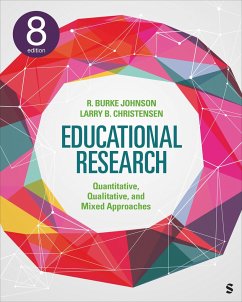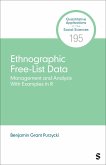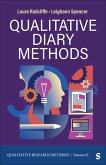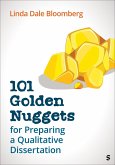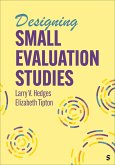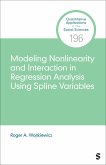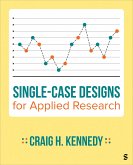Robert Burke Johnson, Larry B. Christensen
Educational Research
Quantitative, Qualitative, and Mixed Approaches
Robert Burke Johnson, Larry B. Christensen
Educational Research
Quantitative, Qualitative, and Mixed Approaches
- Broschiertes Buch
- Merkliste
- Auf die Merkliste
- Bewerten Bewerten
- Teilen
- Produkt teilen
- Produkterinnerung
- Produkterinnerung
Educational Research: Quantitative, Qualitative, and Mixed Approaches offers an accessible introduction to research methods. Providing an in-depth understanding of research methodologies in education, this book illustrates how to read and critically evaluate published research, how to write a proposal, construct research tools, and conduct empirical research using qualitative, quantitative, and mixed methods research approaches.
Andere Kunden interessierten sich auch für
![The Concerns Based Adoption Model (CBAM) The Concerns Based Adoption Model (CBAM)]() The Concerns Based Adoption Model (CBAM)95,99 €
The Concerns Based Adoption Model (CBAM)95,99 €![Ethnographic Free-List Data Ethnographic Free-List Data]() Benjamin Grant PurzyckiEthnographic Free-List Data42,99 €
Benjamin Grant PurzyckiEthnographic Free-List Data42,99 €![Qualitative Diary Methods Qualitative Diary Methods]() Laura RadcliffeQualitative Diary Methods42,99 €
Laura RadcliffeQualitative Diary Methods42,99 €![101 Golden Nuggets for Preparing a Qualitative Dissertation 101 Golden Nuggets for Preparing a Qualitative Dissertation]() Linda Dale Bloomberg101 Golden Nuggets for Preparing a Qualitative Dissertation39,99 €
Linda Dale Bloomberg101 Golden Nuggets for Preparing a Qualitative Dissertation39,99 €![Designing Small Evaluation Studies Designing Small Evaluation Studies]() Larry V. HedgesDesigning Small Evaluation Studies68,99 €
Larry V. HedgesDesigning Small Evaluation Studies68,99 €![Modeling Nonlinearity and Interaction in Regression Analysis Using Spline Variables Modeling Nonlinearity and Interaction in Regression Analysis Using Spline Variables]() Roger A. WojtkiewiczModeling Nonlinearity and Interaction in Regression Analysis Using Spline Variables42,99 €
Roger A. WojtkiewiczModeling Nonlinearity and Interaction in Regression Analysis Using Spline Variables42,99 €![Single-Case Designs for Applied Research Single-Case Designs for Applied Research]() Craig H. KennedySingle-Case Designs for Applied Research95,99 €
Craig H. KennedySingle-Case Designs for Applied Research95,99 €-
-
-
Educational Research: Quantitative, Qualitative, and Mixed Approaches offers an accessible introduction to research methods. Providing an in-depth understanding of research methodologies in education, this book illustrates how to read and critically evaluate published research, how to write a proposal, construct research tools, and conduct empirical research using qualitative, quantitative, and mixed methods research approaches.
Produktdetails
- Produktdetails
- Verlag: Sage Publications Inc Ebooks
- 8 Revised edition
- Seitenzahl: 740
- Erscheinungstermin: 14. Dezember 2024
- Englisch
- Abmessung: 254mm x 203mm x 45mm
- Gewicht: 1750g
- ISBN-13: 9781071965818
- ISBN-10: 1071965816
- Artikelnr.: 71160674
- Herstellerkennzeichnung Die Herstellerinformationen sind derzeit nicht verfügbar.
- Verlag: Sage Publications Inc Ebooks
- 8 Revised edition
- Seitenzahl: 740
- Erscheinungstermin: 14. Dezember 2024
- Englisch
- Abmessung: 254mm x 203mm x 45mm
- Gewicht: 1750g
- ISBN-13: 9781071965818
- ISBN-10: 1071965816
- Artikelnr.: 71160674
- Herstellerkennzeichnung Die Herstellerinformationen sind derzeit nicht verfügbar.
Burke Johnson is a professor in the Professional Studies Department at the University of South Alabama. His PhD is from the REMS (research, evaluation, measurement, and statistics) program in the College of Education at the University of Georgia. He also has graduate degrees in psychology, sociology, and public administration, which have provided him with a multidisciplinary perspective on research methodology. He was guest editor for a special issue of Research in the Schools focusing on mixed research (available online at www.msera.org/rits_131.htm) and completed a similar guest editorship for the American Behavioral Scientist. He was an associate editor of the Journal of Mixed Methods Research. Burke is first author of Educational Research: Quantitative, Qualitative, and Mixed Approaches (Sage, 2014, 5th edition); second author of Research Methods, Design, and Analysis (Pearson, 2014, 12th edition); coeditor (with Sharlene Hesse-Biber) of The Oxford Handbook of Multimethod and Mixed Methods Research Inquiry (2015); coeditor (with Paul Vogt) of Correlation and Regression Analysis (2012); and associate editor of The SAGE Glossary of the Social and Behavioral Sciences (2009).
Preface
Acknowledgments
Part I: Introduction
Chapter 1: Introduction to Educational Research
Why Study Educational Research?
Areas and Examples of Educational Research
General Kinds of Research
Primary Sources of Knowledge
The Scientific Approach to Knowledge Generation
Six Major Objectives of Educational Research
Overview of This Book
Chapter 2: Quantitative, Qualitative, and Mixed Methods Research
What Is a Research Paradigm?
Characteristics of the Three Research Paradigms
Quantitative Research Methods: Experimental and Nonexperimental Research
Qualitative Research Methods
Mixed Methods Research (or Mixed Research)
Our Research Typology
Chapter 3: Action Research for Lifelong Learning
Defining Action Research
Scientific Research and Action Research
Types of Action Research
The Cycle of Action Research
Strengths and Weaknesses of Action Research
Action Research Journaling
Action Research in the Remaining Chapters of This Book
Part II: Planning the Research Study
Chapter 4: How to Critically Review the Literature and Develop Good
Research Questions
Sources of Research Ideas
Review of the Literature
Statement of the Research Problem
Statement of the Purpose of the Study
Statement of Research Questions
Formulating Hypotheses
Consumer Use of the Literature
Action Research Reflection
Chapter 5: How to Write a Research Proposal
Framework of the Research Proposal
Strategies for Writing Each Section of a Research Proposal
Action Research Reflection
Chapter 6: Research Ethics
Philosophical Approaches to Ethics Research
Ethical Concerns
Ethical Guidelines for Research With Humans
Institutional Review Board (IRB)
Ethical Issues in Internet-Based Research
Ethical Issues When Preparing a Research Report
Action Research Reflection
Part III: Foundations of Research
Chapter 7: Standardized Measurement and Assessment
Defining Measurement
Assumptions Underlying Testing and Assessment
Identifying a Good Test or Assessment Procedure
Reliability
Validity
Educational and Psychological Tests
Sources of Information About Tests
Action Research Reflection
Chapter 8: Methods of Data Collection in Quantitative, Qualitative, and
Mixed Methods Research
The Six Major Methods of Data Collection
Mixing Methods of Data Collection
Tests
Questionnaires
Interviews
Focus Groups
Observation
Constructed, Secondary, and Existing Data
Action Research Reflection
Chapter 9: How to Construct a Questionnaire
What Is a Questionnaire?
Principles of Questionnaire Construction
Putting It All Together
Action Research Reflection
Chapter 10: Sampling in Quantitative, Qualitative, and Mixed Methods
Research
Terminology Used in Sampling
Random Sampling Techniques
Nonrandom Sampling Techniques
The Difference Between Random Selection and Random Assignment
Determining the Sample Size When Random Sampling Is Used
Sampling in Qualitative Research
Sampling in Mixed Methods Research
Action Research Reflection
Chapter 11: Validity of Research Results in Quantitative, Qualitative, and
Mixed Methods Research
Validity Issues in the Design of Quantitative Research
Internal or Causation Validity
External Validity or Generalizing Validity
Construct Validity
Statistical Conclusion Validity
Research Validity (or "Trustworthiness") in Qualitative Research
Research Validity (or "Legitimation") in Mixed Methods Research
Action Research Reflection
Part IV: Selecting a Research Method
Section A. Quantitative Research Methods: Five Major Approaches
Chapter 12: Experimental Research: Weak and Strong Designs
The Experiment
Independent Variable Manipulation
How to Control for Confounding Variables
Experimental Research Designs
Basic Strong Experimental Research Designs
Advanced Strong Experimental Research Designs
Action Research Reflection
Chapter 13: Experimental Research: Quasi-Experimental and Single-Case
Designs
Quasi-Experimental Research Designs
Single-Case Experimental Designs
Action Research Reflection
Chapter 14: Nonexperimental Quantitative Research
Steps in Nonexperimental Research
Three Required Conditions for Cause-and-Effect Relationships
Applying the Three Required Conditions for Causation in Nonexperimental
Research
Techniques of Control in Nonexperimental Research (i.e., How to Design
Strong Nonexperimental Research)
Interlude (the Study of Causal Relationships in Epidemiology)
Classifying Nonexperimental Research by Time and Research Objective
The Time Dimension in Nonexperimental Research Design
The Research Objective Dimension in Nonexperimental Research Design
Action Research Reflection
Section B. Qualitative Research Methods: Five Major Approaches
Chapter 15: Narrative Inquiry and Case Study Research
Qualitative Research Design
Narrative Inquiry
Case Study Research
Action Research Reflection
Chapter 16: Phenomenology, Ethnography, and Grounded Theory
Phenomenology
Ethnography
Grounded Theory
Action Research Reflection
Section C. Mixed Methods Research: Many Approaches
Chapter 17: Mixed Methods Research
Strengths and Limitations of Quantitative and Qualitative Research
Strengths, Limitations, and Reasoning in Mixed Methods Research
Constructing Mixed Methods Research Designs
Stages of the Mixed Methods Research Process
Limitations of Mixed Methods Research
Action Research Reflection
Part V: Analyzing the Data
Chapter 18: Descriptive Statistics
Descriptive Versus Inferential Statistics
Graphic Representations of Data
Measures of Central Tendency
Measures of Variability
Measures of Relative Standing
Examining Relationships Among Variables
Action Research Reflection
Chapter 19: Inferential Statistics
Four Fundamental Points
The Concept of a Sampling Distribution
Estimation
Hypothesis Testing
Hypothesis Testing in Research Practice
Action Research Reflection
Chapter 19 Appendix
Chapter 20: Data Analysis in Qualitative and Mixed Methods Research
Interim Analysis
Segmenting, Coding, and Developing Category Systems
Thematic Analysis and Creating Hierarchical Category Systems
Identifying Relationships Among Categories
Computer Programs for Qualitative and Mixed Methods Data Analysis
Data Analysis in Mixed Methods Research
Action Research Reflection
Chapter 20 Appendix: Additional Types of Codes for Qualitative Research
Thirteen Additional Types of Coding
Part VI: Writing the Research Report
Chapter 21: How to Prepare a Research Report and Use APA Style Guidelines
General Principles When Writing Your Research Report Using APA Style (I)
Writing an APA-Style Quantitative Research Report (II)
Example of an APA-Style Manuscript
Writing Qualitative Research Reports
Writing Mixed Methods Research Reports
Action Research Reflection
Glossary
References
Index
Acknowledgments
Part I: Introduction
Chapter 1: Introduction to Educational Research
Why Study Educational Research?
Areas and Examples of Educational Research
General Kinds of Research
Primary Sources of Knowledge
The Scientific Approach to Knowledge Generation
Six Major Objectives of Educational Research
Overview of This Book
Chapter 2: Quantitative, Qualitative, and Mixed Methods Research
What Is a Research Paradigm?
Characteristics of the Three Research Paradigms
Quantitative Research Methods: Experimental and Nonexperimental Research
Qualitative Research Methods
Mixed Methods Research (or Mixed Research)
Our Research Typology
Chapter 3: Action Research for Lifelong Learning
Defining Action Research
Scientific Research and Action Research
Types of Action Research
The Cycle of Action Research
Strengths and Weaknesses of Action Research
Action Research Journaling
Action Research in the Remaining Chapters of This Book
Part II: Planning the Research Study
Chapter 4: How to Critically Review the Literature and Develop Good
Research Questions
Sources of Research Ideas
Review of the Literature
Statement of the Research Problem
Statement of the Purpose of the Study
Statement of Research Questions
Formulating Hypotheses
Consumer Use of the Literature
Action Research Reflection
Chapter 5: How to Write a Research Proposal
Framework of the Research Proposal
Strategies for Writing Each Section of a Research Proposal
Action Research Reflection
Chapter 6: Research Ethics
Philosophical Approaches to Ethics Research
Ethical Concerns
Ethical Guidelines for Research With Humans
Institutional Review Board (IRB)
Ethical Issues in Internet-Based Research
Ethical Issues When Preparing a Research Report
Action Research Reflection
Part III: Foundations of Research
Chapter 7: Standardized Measurement and Assessment
Defining Measurement
Assumptions Underlying Testing and Assessment
Identifying a Good Test or Assessment Procedure
Reliability
Validity
Educational and Psychological Tests
Sources of Information About Tests
Action Research Reflection
Chapter 8: Methods of Data Collection in Quantitative, Qualitative, and
Mixed Methods Research
The Six Major Methods of Data Collection
Mixing Methods of Data Collection
Tests
Questionnaires
Interviews
Focus Groups
Observation
Constructed, Secondary, and Existing Data
Action Research Reflection
Chapter 9: How to Construct a Questionnaire
What Is a Questionnaire?
Principles of Questionnaire Construction
Putting It All Together
Action Research Reflection
Chapter 10: Sampling in Quantitative, Qualitative, and Mixed Methods
Research
Terminology Used in Sampling
Random Sampling Techniques
Nonrandom Sampling Techniques
The Difference Between Random Selection and Random Assignment
Determining the Sample Size When Random Sampling Is Used
Sampling in Qualitative Research
Sampling in Mixed Methods Research
Action Research Reflection
Chapter 11: Validity of Research Results in Quantitative, Qualitative, and
Mixed Methods Research
Validity Issues in the Design of Quantitative Research
Internal or Causation Validity
External Validity or Generalizing Validity
Construct Validity
Statistical Conclusion Validity
Research Validity (or "Trustworthiness") in Qualitative Research
Research Validity (or "Legitimation") in Mixed Methods Research
Action Research Reflection
Part IV: Selecting a Research Method
Section A. Quantitative Research Methods: Five Major Approaches
Chapter 12: Experimental Research: Weak and Strong Designs
The Experiment
Independent Variable Manipulation
How to Control for Confounding Variables
Experimental Research Designs
Basic Strong Experimental Research Designs
Advanced Strong Experimental Research Designs
Action Research Reflection
Chapter 13: Experimental Research: Quasi-Experimental and Single-Case
Designs
Quasi-Experimental Research Designs
Single-Case Experimental Designs
Action Research Reflection
Chapter 14: Nonexperimental Quantitative Research
Steps in Nonexperimental Research
Three Required Conditions for Cause-and-Effect Relationships
Applying the Three Required Conditions for Causation in Nonexperimental
Research
Techniques of Control in Nonexperimental Research (i.e., How to Design
Strong Nonexperimental Research)
Interlude (the Study of Causal Relationships in Epidemiology)
Classifying Nonexperimental Research by Time and Research Objective
The Time Dimension in Nonexperimental Research Design
The Research Objective Dimension in Nonexperimental Research Design
Action Research Reflection
Section B. Qualitative Research Methods: Five Major Approaches
Chapter 15: Narrative Inquiry and Case Study Research
Qualitative Research Design
Narrative Inquiry
Case Study Research
Action Research Reflection
Chapter 16: Phenomenology, Ethnography, and Grounded Theory
Phenomenology
Ethnography
Grounded Theory
Action Research Reflection
Section C. Mixed Methods Research: Many Approaches
Chapter 17: Mixed Methods Research
Strengths and Limitations of Quantitative and Qualitative Research
Strengths, Limitations, and Reasoning in Mixed Methods Research
Constructing Mixed Methods Research Designs
Stages of the Mixed Methods Research Process
Limitations of Mixed Methods Research
Action Research Reflection
Part V: Analyzing the Data
Chapter 18: Descriptive Statistics
Descriptive Versus Inferential Statistics
Graphic Representations of Data
Measures of Central Tendency
Measures of Variability
Measures of Relative Standing
Examining Relationships Among Variables
Action Research Reflection
Chapter 19: Inferential Statistics
Four Fundamental Points
The Concept of a Sampling Distribution
Estimation
Hypothesis Testing
Hypothesis Testing in Research Practice
Action Research Reflection
Chapter 19 Appendix
Chapter 20: Data Analysis in Qualitative and Mixed Methods Research
Interim Analysis
Segmenting, Coding, and Developing Category Systems
Thematic Analysis and Creating Hierarchical Category Systems
Identifying Relationships Among Categories
Computer Programs for Qualitative and Mixed Methods Data Analysis
Data Analysis in Mixed Methods Research
Action Research Reflection
Chapter 20 Appendix: Additional Types of Codes for Qualitative Research
Thirteen Additional Types of Coding
Part VI: Writing the Research Report
Chapter 21: How to Prepare a Research Report and Use APA Style Guidelines
General Principles When Writing Your Research Report Using APA Style (I)
Writing an APA-Style Quantitative Research Report (II)
Example of an APA-Style Manuscript
Writing Qualitative Research Reports
Writing Mixed Methods Research Reports
Action Research Reflection
Glossary
References
Index
Preface
Acknowledgments
Part I: Introduction
Chapter 1: Introduction to Educational Research
Why Study Educational Research?
Areas and Examples of Educational Research
General Kinds of Research
Primary Sources of Knowledge
The Scientific Approach to Knowledge Generation
Six Major Objectives of Educational Research
Overview of This Book
Chapter 2: Quantitative, Qualitative, and Mixed Methods Research
What Is a Research Paradigm?
Characteristics of the Three Research Paradigms
Quantitative Research Methods: Experimental and Nonexperimental Research
Qualitative Research Methods
Mixed Methods Research (or Mixed Research)
Our Research Typology
Chapter 3: Action Research for Lifelong Learning
Defining Action Research
Scientific Research and Action Research
Types of Action Research
The Cycle of Action Research
Strengths and Weaknesses of Action Research
Action Research Journaling
Action Research in the Remaining Chapters of This Book
Part II: Planning the Research Study
Chapter 4: How to Critically Review the Literature and Develop Good
Research Questions
Sources of Research Ideas
Review of the Literature
Statement of the Research Problem
Statement of the Purpose of the Study
Statement of Research Questions
Formulating Hypotheses
Consumer Use of the Literature
Action Research Reflection
Chapter 5: How to Write a Research Proposal
Framework of the Research Proposal
Strategies for Writing Each Section of a Research Proposal
Action Research Reflection
Chapter 6: Research Ethics
Philosophical Approaches to Ethics Research
Ethical Concerns
Ethical Guidelines for Research With Humans
Institutional Review Board (IRB)
Ethical Issues in Internet-Based Research
Ethical Issues When Preparing a Research Report
Action Research Reflection
Part III: Foundations of Research
Chapter 7: Standardized Measurement and Assessment
Defining Measurement
Assumptions Underlying Testing and Assessment
Identifying a Good Test or Assessment Procedure
Reliability
Validity
Educational and Psychological Tests
Sources of Information About Tests
Action Research Reflection
Chapter 8: Methods of Data Collection in Quantitative, Qualitative, and
Mixed Methods Research
The Six Major Methods of Data Collection
Mixing Methods of Data Collection
Tests
Questionnaires
Interviews
Focus Groups
Observation
Constructed, Secondary, and Existing Data
Action Research Reflection
Chapter 9: How to Construct a Questionnaire
What Is a Questionnaire?
Principles of Questionnaire Construction
Putting It All Together
Action Research Reflection
Chapter 10: Sampling in Quantitative, Qualitative, and Mixed Methods
Research
Terminology Used in Sampling
Random Sampling Techniques
Nonrandom Sampling Techniques
The Difference Between Random Selection and Random Assignment
Determining the Sample Size When Random Sampling Is Used
Sampling in Qualitative Research
Sampling in Mixed Methods Research
Action Research Reflection
Chapter 11: Validity of Research Results in Quantitative, Qualitative, and
Mixed Methods Research
Validity Issues in the Design of Quantitative Research
Internal or Causation Validity
External Validity or Generalizing Validity
Construct Validity
Statistical Conclusion Validity
Research Validity (or "Trustworthiness") in Qualitative Research
Research Validity (or "Legitimation") in Mixed Methods Research
Action Research Reflection
Part IV: Selecting a Research Method
Section A. Quantitative Research Methods: Five Major Approaches
Chapter 12: Experimental Research: Weak and Strong Designs
The Experiment
Independent Variable Manipulation
How to Control for Confounding Variables
Experimental Research Designs
Basic Strong Experimental Research Designs
Advanced Strong Experimental Research Designs
Action Research Reflection
Chapter 13: Experimental Research: Quasi-Experimental and Single-Case
Designs
Quasi-Experimental Research Designs
Single-Case Experimental Designs
Action Research Reflection
Chapter 14: Nonexperimental Quantitative Research
Steps in Nonexperimental Research
Three Required Conditions for Cause-and-Effect Relationships
Applying the Three Required Conditions for Causation in Nonexperimental
Research
Techniques of Control in Nonexperimental Research (i.e., How to Design
Strong Nonexperimental Research)
Interlude (the Study of Causal Relationships in Epidemiology)
Classifying Nonexperimental Research by Time and Research Objective
The Time Dimension in Nonexperimental Research Design
The Research Objective Dimension in Nonexperimental Research Design
Action Research Reflection
Section B. Qualitative Research Methods: Five Major Approaches
Chapter 15: Narrative Inquiry and Case Study Research
Qualitative Research Design
Narrative Inquiry
Case Study Research
Action Research Reflection
Chapter 16: Phenomenology, Ethnography, and Grounded Theory
Phenomenology
Ethnography
Grounded Theory
Action Research Reflection
Section C. Mixed Methods Research: Many Approaches
Chapter 17: Mixed Methods Research
Strengths and Limitations of Quantitative and Qualitative Research
Strengths, Limitations, and Reasoning in Mixed Methods Research
Constructing Mixed Methods Research Designs
Stages of the Mixed Methods Research Process
Limitations of Mixed Methods Research
Action Research Reflection
Part V: Analyzing the Data
Chapter 18: Descriptive Statistics
Descriptive Versus Inferential Statistics
Graphic Representations of Data
Measures of Central Tendency
Measures of Variability
Measures of Relative Standing
Examining Relationships Among Variables
Action Research Reflection
Chapter 19: Inferential Statistics
Four Fundamental Points
The Concept of a Sampling Distribution
Estimation
Hypothesis Testing
Hypothesis Testing in Research Practice
Action Research Reflection
Chapter 19 Appendix
Chapter 20: Data Analysis in Qualitative and Mixed Methods Research
Interim Analysis
Segmenting, Coding, and Developing Category Systems
Thematic Analysis and Creating Hierarchical Category Systems
Identifying Relationships Among Categories
Computer Programs for Qualitative and Mixed Methods Data Analysis
Data Analysis in Mixed Methods Research
Action Research Reflection
Chapter 20 Appendix: Additional Types of Codes for Qualitative Research
Thirteen Additional Types of Coding
Part VI: Writing the Research Report
Chapter 21: How to Prepare a Research Report and Use APA Style Guidelines
General Principles When Writing Your Research Report Using APA Style (I)
Writing an APA-Style Quantitative Research Report (II)
Example of an APA-Style Manuscript
Writing Qualitative Research Reports
Writing Mixed Methods Research Reports
Action Research Reflection
Glossary
References
Index
Acknowledgments
Part I: Introduction
Chapter 1: Introduction to Educational Research
Why Study Educational Research?
Areas and Examples of Educational Research
General Kinds of Research
Primary Sources of Knowledge
The Scientific Approach to Knowledge Generation
Six Major Objectives of Educational Research
Overview of This Book
Chapter 2: Quantitative, Qualitative, and Mixed Methods Research
What Is a Research Paradigm?
Characteristics of the Three Research Paradigms
Quantitative Research Methods: Experimental and Nonexperimental Research
Qualitative Research Methods
Mixed Methods Research (or Mixed Research)
Our Research Typology
Chapter 3: Action Research for Lifelong Learning
Defining Action Research
Scientific Research and Action Research
Types of Action Research
The Cycle of Action Research
Strengths and Weaknesses of Action Research
Action Research Journaling
Action Research in the Remaining Chapters of This Book
Part II: Planning the Research Study
Chapter 4: How to Critically Review the Literature and Develop Good
Research Questions
Sources of Research Ideas
Review of the Literature
Statement of the Research Problem
Statement of the Purpose of the Study
Statement of Research Questions
Formulating Hypotheses
Consumer Use of the Literature
Action Research Reflection
Chapter 5: How to Write a Research Proposal
Framework of the Research Proposal
Strategies for Writing Each Section of a Research Proposal
Action Research Reflection
Chapter 6: Research Ethics
Philosophical Approaches to Ethics Research
Ethical Concerns
Ethical Guidelines for Research With Humans
Institutional Review Board (IRB)
Ethical Issues in Internet-Based Research
Ethical Issues When Preparing a Research Report
Action Research Reflection
Part III: Foundations of Research
Chapter 7: Standardized Measurement and Assessment
Defining Measurement
Assumptions Underlying Testing and Assessment
Identifying a Good Test or Assessment Procedure
Reliability
Validity
Educational and Psychological Tests
Sources of Information About Tests
Action Research Reflection
Chapter 8: Methods of Data Collection in Quantitative, Qualitative, and
Mixed Methods Research
The Six Major Methods of Data Collection
Mixing Methods of Data Collection
Tests
Questionnaires
Interviews
Focus Groups
Observation
Constructed, Secondary, and Existing Data
Action Research Reflection
Chapter 9: How to Construct a Questionnaire
What Is a Questionnaire?
Principles of Questionnaire Construction
Putting It All Together
Action Research Reflection
Chapter 10: Sampling in Quantitative, Qualitative, and Mixed Methods
Research
Terminology Used in Sampling
Random Sampling Techniques
Nonrandom Sampling Techniques
The Difference Between Random Selection and Random Assignment
Determining the Sample Size When Random Sampling Is Used
Sampling in Qualitative Research
Sampling in Mixed Methods Research
Action Research Reflection
Chapter 11: Validity of Research Results in Quantitative, Qualitative, and
Mixed Methods Research
Validity Issues in the Design of Quantitative Research
Internal or Causation Validity
External Validity or Generalizing Validity
Construct Validity
Statistical Conclusion Validity
Research Validity (or "Trustworthiness") in Qualitative Research
Research Validity (or "Legitimation") in Mixed Methods Research
Action Research Reflection
Part IV: Selecting a Research Method
Section A. Quantitative Research Methods: Five Major Approaches
Chapter 12: Experimental Research: Weak and Strong Designs
The Experiment
Independent Variable Manipulation
How to Control for Confounding Variables
Experimental Research Designs
Basic Strong Experimental Research Designs
Advanced Strong Experimental Research Designs
Action Research Reflection
Chapter 13: Experimental Research: Quasi-Experimental and Single-Case
Designs
Quasi-Experimental Research Designs
Single-Case Experimental Designs
Action Research Reflection
Chapter 14: Nonexperimental Quantitative Research
Steps in Nonexperimental Research
Three Required Conditions for Cause-and-Effect Relationships
Applying the Three Required Conditions for Causation in Nonexperimental
Research
Techniques of Control in Nonexperimental Research (i.e., How to Design
Strong Nonexperimental Research)
Interlude (the Study of Causal Relationships in Epidemiology)
Classifying Nonexperimental Research by Time and Research Objective
The Time Dimension in Nonexperimental Research Design
The Research Objective Dimension in Nonexperimental Research Design
Action Research Reflection
Section B. Qualitative Research Methods: Five Major Approaches
Chapter 15: Narrative Inquiry and Case Study Research
Qualitative Research Design
Narrative Inquiry
Case Study Research
Action Research Reflection
Chapter 16: Phenomenology, Ethnography, and Grounded Theory
Phenomenology
Ethnography
Grounded Theory
Action Research Reflection
Section C. Mixed Methods Research: Many Approaches
Chapter 17: Mixed Methods Research
Strengths and Limitations of Quantitative and Qualitative Research
Strengths, Limitations, and Reasoning in Mixed Methods Research
Constructing Mixed Methods Research Designs
Stages of the Mixed Methods Research Process
Limitations of Mixed Methods Research
Action Research Reflection
Part V: Analyzing the Data
Chapter 18: Descriptive Statistics
Descriptive Versus Inferential Statistics
Graphic Representations of Data
Measures of Central Tendency
Measures of Variability
Measures of Relative Standing
Examining Relationships Among Variables
Action Research Reflection
Chapter 19: Inferential Statistics
Four Fundamental Points
The Concept of a Sampling Distribution
Estimation
Hypothesis Testing
Hypothesis Testing in Research Practice
Action Research Reflection
Chapter 19 Appendix
Chapter 20: Data Analysis in Qualitative and Mixed Methods Research
Interim Analysis
Segmenting, Coding, and Developing Category Systems
Thematic Analysis and Creating Hierarchical Category Systems
Identifying Relationships Among Categories
Computer Programs for Qualitative and Mixed Methods Data Analysis
Data Analysis in Mixed Methods Research
Action Research Reflection
Chapter 20 Appendix: Additional Types of Codes for Qualitative Research
Thirteen Additional Types of Coding
Part VI: Writing the Research Report
Chapter 21: How to Prepare a Research Report and Use APA Style Guidelines
General Principles When Writing Your Research Report Using APA Style (I)
Writing an APA-Style Quantitative Research Report (II)
Example of an APA-Style Manuscript
Writing Qualitative Research Reports
Writing Mixed Methods Research Reports
Action Research Reflection
Glossary
References
Index

